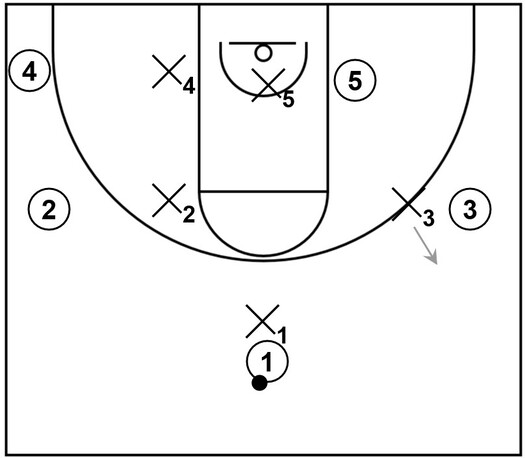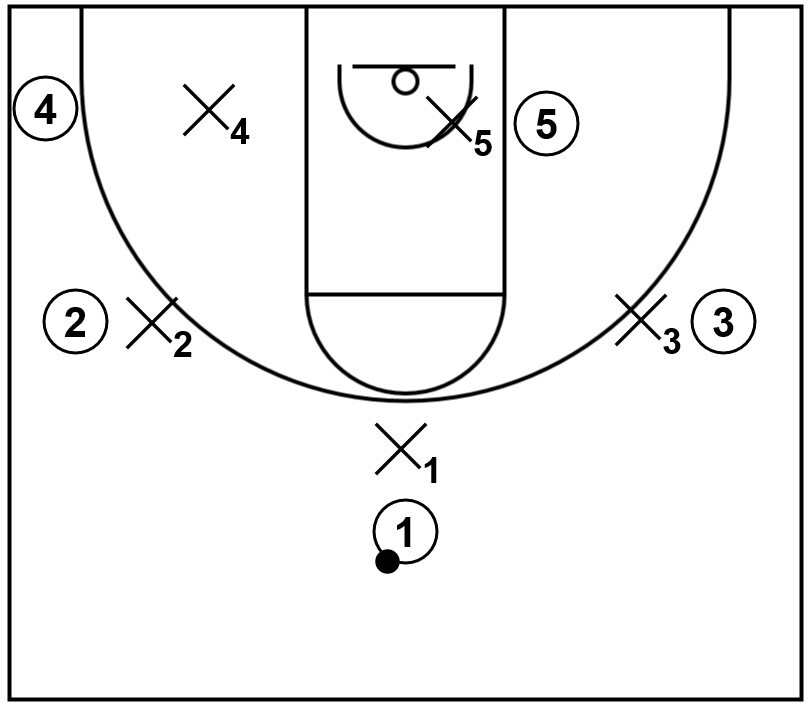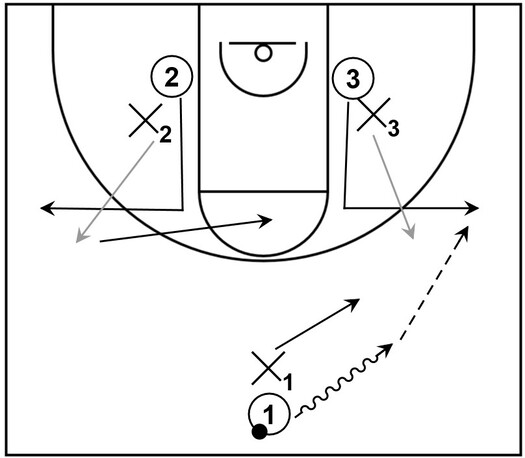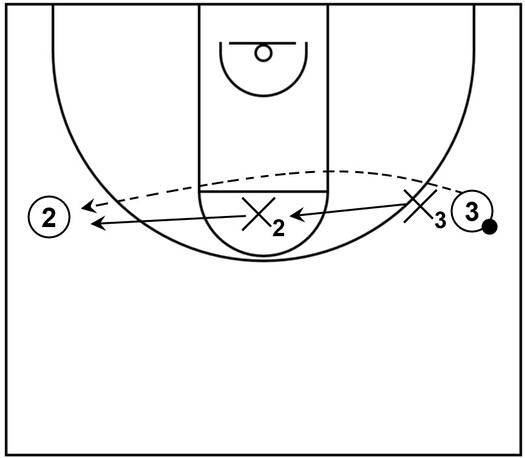General definition of pressure defense
Pressure defense, in general, comprises basketball concepts that could be executed by one or more defenders in a full court or half court setting to disrupt offensive productivity which could lead to detrimental offensive results such as low quality shot attempts and/or turnovers.
Furthermore, pressure defense could potentially be effective because it could constrain at least one offensive player into executing undesirable actions that are not beneficial to them or the offensive team as a whole.
General systems that could potentially incorporate pressure defense concepts
Man to man defense
Man to man defense is a type of basketball defensive system in which each defender guards a certain offensive player, typically based on their respective basketball positions, ultimately to limit or prevent scoring opportunities near the basket or near the perimeter.
Pressure defense is generally implemented in the man to man defensive system by the on-ball defender who typically crowds the player in possession of the basketball, primarily to limit dribble penetration and/or to prevent uncontested field goal attempts.
Furthermore, there are variations of man to man defense which also implement pressure defense functionality such as the ball line defense and the pack line defense.
The diagram below demonstrates an example of on-ball pressure within man to man defense.
Additionally, each of the offensive players on the diagrams below as well as within subsequent sections later are generally represented by the standard positions and that would apply to defensive players as well, unless otherwise noted.
Essentially, 1 and X1 are the offensive and defensive point guards, respectively.
2 and X2 are the offensive and defensive shooting guards, respectively.
3 and X3 are the offensive and defensive small forwards, respectively.
4 and X4 are the offensive and defensive power forwards, respectively.
5 and X5 represent the offensive and defensive center positions, respectively.
On-ball pressure within man to man defense | Ball at top

In terms of the basic offensive setup for this example: 1 is at the top in possession of the ball; 2 and 3 are near the left and right side wings, respectively; 4 is located near the left side corner; 5 occupies the right side low post area.
Conversely, in relation to the defensive players: X1 is at the top and currently implements on-ball pressure against 1; X2 guards just within the three-point line near the high post elbow on the left side; X3 is just outside of the three-point line, even closer to the right side wing; X4 currently slides over towards the left side low post area away from 4; X5 guards within the lane, right in front of the basket.
Also, X1 utilizes defensive pressure against 1 in an attempt to disrupt the team’s offensive flow. In other words, X1 is trying to make it much more challenging for 1 to execute their team’s basketball offense and/or set plays.
X2, as stated, is just inside of the three-point line and effectively playing a sagging defense, which ironically in this case, is the opposite of pressure defense.
For this example, let’s also assume that 2 is a non-shooter (i.e their three-point shot is below average) and generally not considered as an offensive threat.
What’s more, by sagging away from the main assignment (that being 2), X2 can potentially provide help defense if 1 tried to dribble the ball towards the lane on that side.
On the other hand, let’s assume that 3 has an above average three-point shot. Therefore, X3 is guarding that offensive player with greater intensity.
Moreover, for this example, let’s also assume that X3 is even playing denial defense, represented by the gray arrow, in an attempt to prevent 3 from easily receiving possession of the basketball.
Essentially, X3 is playing off-ball pressure defense.
X4, somewhat similar to X2, is guarding away from their main check. This is because 4 is two passes away. In other words, assuming offensive players remain in their current spots, one pass would have to go towards 2 (i.e. 1 passes to 2) first and then from there, a second pass could reach 4 (2 passes to 4).
1 could also throw a skip pass over 2 to reach 4 but the two passes away concept would still remain.
In either case, X4 doesn’t necessarily need to be very close to 4 at the moment. Regardless if 4 receives the ball, either via a standard pass by 2 or a skip pass by 1, X4 would have enough time to closeout and potentially implement pressure defense against 4 near that corner area.
In addition to that, being near the left post area allows X4 to help on dribble penetration, assuming 1 was able to beat X1 and X2 or against a basket cut by an off-ball player such as 2, 3, or 4.
X5 for all intents and purposes, is simply protecting the basket and tracking the location of the ball. Also, even if 3 tries to counter the denial action of X3 with a backdoor cut, X5 as well as X4 are near the basket, ready to protect the rim, block a shot, or simply contest a close-range shot.
What’s more, for this example, if 5 received possession of the ball, either because X3 didn’t deny or because 1 somehow threw the ball over the defense, X5 could slide over closer to the right side lane line and implement defensive pressure against 5.
Moreover, X4 could slide into the lane as a safety or secondary barrier for basket protection.
Zone defense
Zone defense is a type of basketball defensive system in which each defender guards a certain area on the court and by extension, any offensive player that enters into that zone defender’s respective area.
The typical objectives of zone defenses are to hinder dribble penetration, restrict low post scoring opportunities, and influence jump shots, particularly from offensive teams with below average perimeter shooting abilities.
In terms of pressure defense, it is usually implemented in odd front zones such as 1-1-3 zone defense, the 1-2-2 zone defense, or the 1-3-1 zone defense.
An odd-front zone features one particular defender at the front or top of the zone that usually executes the pressure defense, typically against the player with the ball that initiates the basketball offense at the top.
In addition to that, defensive pressure could also be utilized within certain types of match-up zones as well.
Full court press defense
The full court press is a basketball defense system in which defenders execute backcourt and frontcourt on-ball pressure, typically accompanied by sideline traps against players of the offensive team.
In full court press strategies, the vast majority of the defensive pressure typically occurs in the backcourt and the usual objective is to speed up the offensive player into turning the ball over.
However, if the offensive team is able to get the ball into the frontcourt, then the defensive team could still apply half court pressure as well.
Combination defense
Combination defense is a type of basketball defensive system that incorporates and utilizes components of man to man defense, zone defense, and/or additional defensive tactics to ultimately limit or prevent offensive scoring opportunities.
The different types of combination defense includes defensive strategies such as the Amoeba defense, the various junk defenses such as the box and 1 defense, as well as the run and jump defense among others.
Specific strategies that could possibly implement pressure defense concepts
Ball line defense
The ball line defense is a basketball strategy that implements on-ball defensive pressure and off-ball help defense principles to limit scoring opportunities near the basket while influencing contested perimeter jump shots.
The diagram below demonstrates an example of the ball line defense, particularly when an offensive player has possession of the basketball at the top in the middle of the court.
On-ball pressure within ball line defense | Ball at top

For this basic example, 1 has the ball at the top and is being currently guarded with defensive pressure by X1.
Additionally, X2 and X3 are guarding close to their assignments as well, primarily to deny easy wing entry passes to those offensive players.
X4 is about a step or two away from 4, mainly to hinder potential basket cuts by 2 and 3 or to offer help in the event of dribble penetration by 1.
X5 simply guards against 5 while also focusing on protecting the basket.
Pack line defense
The pack line defense is a basketball strategy that implements on-ball defensive pressure and off-ball actions in which defenders will either sag into the pack line or deny passing lanes to limit or prevent offensive scoring opportunities.
1-1-3 zone defense
The 1-1-3 zone defense is a basketball strategy that seeks to prevent high quality scoring opportunities of the offensive team, especially near the basket, primarily by using certain on-ball or off-ball defensive actions.
1-2-2 zone defense
The 1-2-2 zone defense is a basketball strategy that seeks to limit low post scoring opportunities, restrict dribble penetration, and influence ineffective shot selection while executing on-ball pressure defense, specifically near the perimeter.
1-3-1 zone defense
The 1-3-1 zone defense is a basketball strategy that seeks to disrupt offensive scoring opportunities by influencing contested jump shots and limiting dribble penetration, while executing solid on-ball pressure defense.
1-1-2-1 press defense
The 1-1-2-1 press defense is a basketball strategy that emphasizes defensive pressure as well as traps near the corners, ultimately to create turnovers or at minimum, to disrupt offensive scoring opportunities near the basket or near perimeter areas of the court.
1-1-3 press defense
The 1-1-3 press defense is a basketball strategy that uses on-ball pressure and sideline traps to disrupt offensive flow, which in turn, limits scoring opportunities and generates turnovers.
1-2-1-1 press defense
The 1-2-1-1 press defense, also known as the diamond press, is a basketball strategy that features full court defensive pressure and sideline traps, particularly in the backcourt, which could lead to limited offensive scoring opportunities as well as possible turnovers.
1-2-2 press defense
The 1-2-2 press defense is a basketball defensive strategy that features moderate defensive pressure and sideline traps, particularly in the backcourt or frontcourt, which in turn, could limit offensive scoring opportunities.
1-3-1 press defense
The 1-3-1 press defense is a type of basketball strategy that implements on-ball pressure, particularly in the backcourt, as well as traps near the sidelines, especially in the frontcourt, to limit or prevent offensive scoring opportunities.
2-1-2 press defense
The 2-1-2 press defense is a basketball strategy that implements a modest amount of on-ball pressure, particularly in the backcourt, and sideline traps, especially in the frontcourt, to disrupt the scoring effectiveness of the offensive team with the additional possibility of creating turnovers.
2-2-1 press defense
The 2-2-1 press defense is a basketball strategy that seeks to hinder offensive scoring opportunities with the possibility of creating turnovers by way of on-ball pressure and sideline traps in the backcourt or frontcourt.
Amoeba defense
The Amoeba defense is a basketball strategy that seeks to limit scoring opportunities for the offensive team by implementing on-ball pressure as well as sideline traps while preventing dribble penetration from the perimeter and restricting entry passes into the high or low post areas.
Point zone defense
The point zone defense is a basketball strategy that primarily seeks to prevent dribble penetration with on-ball pressure, hinder low post touches, and influence contested jump shots to ultimately disrupt offensive scoring opportunities near the basket or near the perimeter areas of the court.
Box and 1 defense
The box and 1 defense is a basketball strategy that seeks to limit scoring opportunities, especially for the opposing team’s best perimeter player, particularly by implementing a combination of man to man pressure defense and zone defense principles.
Diamond and 1 defense
The diamond and 1 defense is a basketball strategy and a variation of the box and 1 defense that emphasizes impeding scoring opportunities, particularly for the opposing team’s best perimeter player with man to man pressure defense and zone defense principles.
Triangle and 2 defense
The triangle and 2 defense is a basketball strategy that seeks to inhibit scoring opportunities, primarily for the opposing team’s two best perimeter players, by implementing a mixture of man to man defensive pressure and zone defense concepts.
General aspects of pressure defense in the full court
The general aspects of full court pressure defense are comprised of influencing an offensive player towards a sideline and/or corner, trapping that same player near the sideline and/or corner, protecting the middle of the court to prevent a breaking of the pressure, as well as deflecting or intercepting bad passes when possible.
Influence the offensive player in possession of the basketball towards the sideline
Influence the player with the ball towards the sideline
When an offensive player receives the basketball in the backcourt, an on-ball defender will typically implement defensive pressure to influence that player towards a sideline.
The on-ball defender will essentially use strong defensive principles alongside speed and quickness to keep the player with the ball away from the middle area of the court where it is easier to break the pressure.
Trap the offensive player in possession of the basketball near the sideline
If the on-ball defender is able to successfully influence the offensive player in possession of the basketball towards a sideline via defensive pressure, then an adjacent off-ball defender will typically execute trap defense alongside the on-ball defender that implemented defensive pressure.
Protect the middle area of the court
As the trap action occurs between the on-ball defender and the adjacent off-ball defender, at least one additional off-ball defender will usually cover the middle area of the court.
Doing this makes it much more difficult for the player in possession of the ball to throw it to a teammate towards the middle which would effectively break the pressure.
Intercept or deflect bad passes
If the offensive player in possession of the ball attempts to pass it to a teammate at any time during the initial on-ball pressure or during the potential sideline trap, an off-ball defender that is in the vicinity of the passer’s target could step into the passing lane to intercept or deflect that pass.
If that occurs, it could lead to possible turnovers and subsequent transition offense scoring options for the team that initially executed the full court pressure.
General aspects of pressure defense in the half court
The general aspects of pressure defense in the half court consists of an on-ball defender crowding an offensive player in possession of the ball during situations such as when the ball gets dribbled across the half court line, when the offensive player receives the ball but does immediately dribble it, or when the offensive player has just completed dribbling the ball.
Furthermore, while an on-ball defender implements pressure, one or more off-ball defenders could provide help defense whenever feasible.
Implement extended pressure near the half court line
It is possible to implement extended defensive pressure as soon as the offensive player in possession of the ball dribbles it across the half court line.
When the on-ball defender crowds that offensive player and gets into their space, this could potentially cause a disruption and that same player may not be able to easily initiate their team’s offensive actions.
Additionally, when that offensive player dribbles it across the half court line or at any other time the ball is being dribbled, either in the frontcourt or backcourt, that same offensive player could possibly move too fast due to the on-ball pressure.
If that occurs, the result could be a turnover due to ill-advised offensive actions such as an unnecessary dribbling moves or bad passes as the offensive player attempts to alleviate the pressure.
Implement pressure during triple threat before dribble action
In certain situations, particularly when the ball is near one of the perimeter areas at the top, wings, or corners, the on-ball defender could implement defensive pressure against the player in possession of the ball, even before that same player dribbles it.
In this instance, the offensive player would most likely be in the triple threat position in which they have the option to dribble, shoot or pass the ball.
To counter that triple threat action, the on-ball defender that is implementing pressure defense should execute the proper defensive stance, mirror the ball with active hands, and be ready to slide laterally if necessary.
To execute the proper defensive stance, the on-ball defender should have their feet slightly wider than shoulder width apart, their knees bent, and their back straight while maintaining balance.
Also, the on-ball defender should try to stay on the balls of the feet and not stand flat-footed.
Additionally, as mentioned previously, the on-ball defender should mirror the ball with active hands.
This essentially means that if the ball is high near the offensive player’s chest or above the shoulders, then the hands of the on-ball defender should be high as well.
In contrast, if the ball is low near the offensive player’s waist or below the waist, then the hands of the on-ball defender should be lower as well.
From that point, if the offensive player in possession of the ball attempts to pass it to another teammate, then the on-ball defender with active hands pressuring the ball could possibly deflect it.
That, in turn, could lead to a turnover or even simple offensive inefficiency, which are benefits for the defensive team.
Furthermore, to mitigate the potential shooting opportunity from the triple threat position, the on-ball defender could have an active hand near the face of the potential shooter to discourage the jump shot.
However, it should also be noted that the on-ball defender should not recklessly reach into the space of the player with the ball while implementing defensive pressure as that could lead to an undesirable foul.
Implement pressure during dribble action
If the offensive player in possession of the ball does not pass or shoot, then that same player could potentially dribble the ball instead, particularly towards the basket.
When that occurs, the on-ball defender implementing pressure should be prepared to execute the defensive slide by moving both feet laterally from side to side with one foot leading the other.
For example, if the on-ball defender wants to move to the right (which would be the left side of the court from the offensive player’s point of view), then the defender should move laterally with the right foot leading first followed by the left foot thereafter.
Conversely, if the on-ball defender desires to move to the left (which would be the right side of the court from the offensive player’s perspective), then the defender should move laterally with the left foot leading first followed by the right foot afterwards.
Also, it is important to note that the on-ball defender should try to keep both feet as close to shoulder width apart as possible while executing the lateral slide.
Put another way, the on-ball defender’s feet should never be too close together as that would take away the defender’s lateral quickness.
Furthermore, it is also important to mention that the on-ball defender should not cross both feet while executing the lateral slide.
If that were to occur, not only does this eliminate the on-ball defender’s ability to effectively slide laterally, but it could also cause imbalance.
Implement pressure after complete dribble action
When the offensive player effectively completes their dribble, the on-ball defender could continue to crowd that same offensive player with active hands.
However, as mentioned before, the on-ball defender should not reach in unnecessarily as that could lead to a foul.
If the offensive player takes a shot attempt, particularly from the perimeter areas of the court, then the on-ball defender should be able to contest the shot with a hand in the face of the shooter.
Conversely, if the offensive player is not able to take a shot attempt, then the on-ball defender should use active hands to mirror the ball and possibly block the offensive player’s vision which could lead to a bad pass and potential turnover.
Moreover, as the on-ball defender pressures the ball, any adjacent off-ball defenders that are especially one pass away could execute denial defense to further disrupt the offensive flow.
Affiliate Disclosure: I may earn a commission on qualifying purchases made through the links below.
Pressure defense basketball drill
This is an example of a pressure defense basketball drill based on insights from Disrupting Offenses with Pressure Defense by Brad Underwood.
Also, the offensive and defensive players on the following diagrams do not need to have specified roles or basketball positions for this drill.
Part 1: Wing entry denial

In terms of the setup, player 1 starts near half court while players 2 and 3 start near the left and right side low post areas respectively.
X1 implements on-ball pressure while X2 and X3 initially try to deny the wing entry pass.
When the drill begins, 2 and 3 utilizes L-cuts to get open near the wings while X2 and X3 execute denial defense, shown with the gray arrows.
For this example, let’s assume that 3 is able to hinder the denial action and get open near the right side wing. When that occurs, 1 dribbles towards the right side and passes the ball to 3.
At the same time, X1 implements pressure against 1 without committing an unnecessary defensive foul.
Afterwards, X2, who is on the opposite side of the court, quickly sprints to the high post area, indicated by the black arrow, to protect the nail area, particularly from dribble penetration.
Part 2: Wing pressure and closeout

Next, X3 applies on-ball pressure defense while X2 continues to protect the nail. From there, 2 could receive a skip pass from 3 and during the flight of the pass, X2 should execute a defensive closeout towards 2.
Following that, X2 should implement defensive pressure against 2 and at the same time, X3 should slide laterally towards the high post to protect the nail as well.
Moving forward, 2 and 3 could execute a few skip passes from wing to wing while X2 and X3 continue to practice defensive sliding, closeouts, on-ball pressure, and nail protection.
Also, any of the players, including 1 and X1 from the previous diagram, could switch sides so that each player can practice offensive and defensive skills.
Related: Kevin Boyle: 20 High Energy Drills for Pressure Defense – YouTube